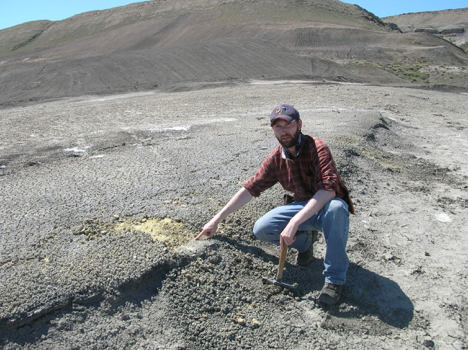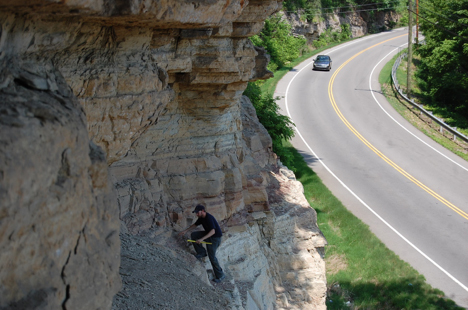Editor’s note: Our featured professional this issue is James Thomka, an assistant professor in the Department of Geosciences at the University of Akron.
What research question currently excites you the most?
I have always been drawn to research areas where the traditional mindset is “there’s no story here.” This scientific field is so broad that there are surely interesting and worthwhile avenues to pursue no matter where one looks, if they dig deeply enough. Currently, three main questions guide most of my active research projects. (1) What factors control preservation of Paleozoic stalked echinoderms, generally and in specific case studies? (2) What are the primary patterns of crinoid preservation, paleoecology, and diversity during the Pennsylvanian? (3) What are the underlying controls on refined linkages between Silurian biological and paleoclimatic-paleoceanographic events? The unifying thread among these disparate topics is that these are all questions that were not viewed as worthy of focused study for much of my student-hood. People who are interested in stalked echinoderms HAVE to do systematics, not taphonomy; people who are interested in upper Paleozoic crinoids HAVE to either work on Mississippian assemblages or the Late Permian biodiversity crisis, not the “uninteresting” Pennsylvanian; people who are interested in middle Paleozoic bio-events HAVE to either work on the Late Ordovician or the Devonian, not the “stable, boring” Silurian. No!!! In reality, there is an immense amount of fascinating, exciting, and valuable paleontological insight that can be gained from addressing these questions, perhaps even more so because they have been largely overlooked for so long.
How did you become interested in stratigraphy and taphonomy? Were you drawn to fossils as a child?
I grew up in Chicago, in a highly developed area where there wasn’t an abundance of natural outcrops. I did, however, have access to phenomenal paleontological material in the form of specimens on display at the Field Museum of Natural History. So, although I wasn’t a collector “out of my backyard” as a child, I was incredibly interested at an early age about the history of the planet. I remember becoming fascinated early on with the famous Mazon Creek siderite concretions—this is what hooked me on invertebrates over the “sexier” dinosaurs and Pleistocene megafauna—and also fundamentally instilled in me the question of “how did this come to be preserved?” Ever since then, issues of taphonomy and stratigraphy, which cannot realistically be separated from each other, have permeated my thoughts. I still work on siderite concretions to this day, primarily because of excitement that was generated when I was in elementary school!

As an early-career professional, your publication record is impressive. What tips/tricks can you share with the myFOSSIL community about paper writing and/or the peer-review process?
Well, I’m not sure how “impressive” my publication record is, but I have always believed that one of the main ethical duties of scientists is to share knowledge. One of my day-to-day mantras is “what would happen if I got hit by a bus tomorrow?” The short answer to that hypothetical question is that anything that I knew but didn’t share would have to be rediscovered from scratch or would be lost forever. I genuinely believe that it is important to get data out to the broader community in an expedient manner, and I think this is something that can help motivate people to submit their manuscripts. If someone has never submitted a paper before, the best thing they can do is read a multitude of papers that they enjoyed or found highly readable—those stylistic elements are likely to penetrate their way into your writing in a positive way. The myFOSSIL community may be particularly useful in this way, as tentative authors might have a means to contact other individuals (academic or avocational) and ask them to look over their prospective manuscript prior to submission.

Given that the goal of FOSSIL is to link amateur groups with professionals, what are your thoughts about the role of amateurs in the science?
I think amateurs are a vital part of the science of paleontology in many situations. In fact, I generally use the term ‘avocational paleontologists’ instead of ‘amateurs,’ since a lot of the interactions I’ve had with them in the field and much of the work I’ve seen them produce is anything but amateurish. I’ve found that there are three main areas where active collaboration between academic and avocational paleontologists is particularly beneficial. First, avocational paleontologists are often the “eyes, ears, and hands” of academic paleontologists in the field, updating others on new exposures or changes in access to old collecting areas, and being able to quickly collect from or document localities that are highly ephemeral. Second, avocational paleontologists often exhaustively collect from their favorite sites for extended periods of time—in some cases decades—resulting in impressive and scientifically valuable collections that can be studied even if sites “dry up” in terms of fossil yield or are destroyed (as in active quarries). Third, avocational paleontological societies are generally willing to volunteer manpower, equipment, or other assets if a major endeavor must be undertaken in a short amount of time—that is, on a timetable that is generally far shorter than the time it takes to apply for and potentially receive a grant that would be used to hire field assistants and rent equipment. All in all, avocational paleontologists are valuable sources of knowledge, specimens, and assistance and can contribute as equals to academic paleontologists in many research projects.

To learn more:
Deline, B., & Thomka, J. R. (2017). The role of preservation on the quantification of morphology and patterns of disparity within Paleozoic echinoderms. Journal of Paleontology, 1-15.
Thomka, J. R., Bantel, T. E., & Tomin, M. J. (2016). Unusual preservation of the trace fossil Conostichus in middle Silurian carbonate facies of Indiana, USA 1. Canadian Journal of Earth Sciences, 53(8), 802-807.
Thomka, J. R., Brett, C. E., Bantel, T. E., Young, A. L., & Bissett, D. L. (2016). Taphonomy of ‘cystoids’(Echinodermata: Diploporita) from the Napoleon quarry of southeastern Indiana, USA: the Lower Silurian Massie Formation as an atypical Lagerstätte. Palaeogeography, Palaeoclimatology, Palaeoecology, 443, 263-277. http://dx.doi.org/10.1016/j.palaeo.2015.11.034
Thomka, J. R., & Brett, C. E. (2015). Palaeontological and sedimentological effects of micro‐bioherms in the Middle Silurian Massie Formation of southeastern Indiana, USA. Lethaia, 48(2), 172-187.
Brett, C. E., Thomka, J. R., Schwalbach, C. E., Aucoin, C. D., & Malgieri, T. J. (2015). Faunal epiboles in the Upper Ordovician of north-central Kentucky: Implications for high-resolution sequence and event stratigraphy and recognition of a major unconformity. Palaeoworld, 24(1), 149-159.http://dx.doi.org/10.1016/j.palwor.2015.01.004
Thomka, J. R., & Brett, C. E. (2015). Paleoecology of pelmatozoan attachment structures from a hardground surface in the middle Silurian Massie Formation, southeastern Indiana. Palaeogeography, Palaeoclimatology, Palaeoecology, 420, 1-12.http://dx.doi.org/10.1016/j.palaeo.2014.12.001